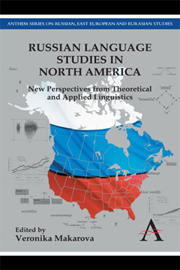Book contents
- Frontmatter
- Contents
- List of Tables and Figures
- Introduction
- Part One Language Structures and their Interface
- Part Two Applied Linguistic and Sociolinguistic Analysis
- 6 Communicative Language Teaching and Russian: The Current State of the Field
- 7 Low-Proficiency Heritage Speakers of Russian: Their Interlanguage System as a Basis for Fast Language (Re)Building
- 8 Superior Speakers or “Super” Russian: OPI Guidelines Revisited
- 9 Who Am I?: Cultural Identities among Russian-Speaking Immigrants of the Third (and Fourth?) Wave and their Effects on Language Attitudes
- 10 Russian Language History in Canada. Doukhobor Internal and External Migrations: Effects on Language Development and Structure
- Afterword
- Index
10 - Russian Language History in Canada. Doukhobor Internal and External Migrations: Effects on Language Development and Structure
from Part Two - Applied Linguistic and Sociolinguistic Analysis
Published online by Cambridge University Press: 05 November 2012
- Frontmatter
- Contents
- List of Tables and Figures
- Introduction
- Part One Language Structures and their Interface
- Part Two Applied Linguistic and Sociolinguistic Analysis
- 6 Communicative Language Teaching and Russian: The Current State of the Field
- 7 Low-Proficiency Heritage Speakers of Russian: Their Interlanguage System as a Basis for Fast Language (Re)Building
- 8 Superior Speakers or “Super” Russian: OPI Guidelines Revisited
- 9 Who Am I?: Cultural Identities among Russian-Speaking Immigrants of the Third (and Fourth?) Wave and their Effects on Language Attitudes
- 10 Russian Language History in Canada. Doukhobor Internal and External Migrations: Effects on Language Development and Structure
- Afterword
- Index
Summary
Introduction
At present, there are about 30,000 Doukhobors in Canada (a higher estimate, i.e., 40,000, is given in Tarasoff 2002, ix): 12,300 in British Columbia; 8,000 in Saskatchewan; 3,000 in Alberta and the rest in other provinces (Popoff 1983, 117). Language maintenance among the Doukhobor population is estimated at about 60 percent, although this figure contains a large number of semi-speakers, especially among the younger generation (see Schaarschmidt 1998). The present linguistic analysis will concentrate on the effects the internal and external migrations of the Doukhobor community have had on the structure and development of the language beginning with the settlement in Milky Waters in 1802. We shall present four synchronic slices in the development of Doukhobor Russian: (1) the formation stage of a compromise language in Milky Waters (Section III); (2) the leveling process in the Transcaucasian stage (Section IV); (3) the development of three functional styles in the early years in Canada (Sections V and VI); and (4) the slow but inevitable erosion of these functional styles especially since the 1940s (Section VI).
Even before the Doukhobors' mass emigration to Canada in 1899, their language was distinct from both Standard Russian and Russian dialects, first as a result of the resettlement from all parts of the Russian Empire to the Crimea, and later, the forced resettlement of the group from the Crimea to Transcaucasia, i.e., to an area with non-Slavic populations.
- Type
- Chapter
- Information
- Russian Language Studies in North AmericaNew Perspectives from Theoretical and Applied Linguistics, pp. 235 - 260Publisher: Anthem PressPrint publication year: 2012
- 3
- Cited by



